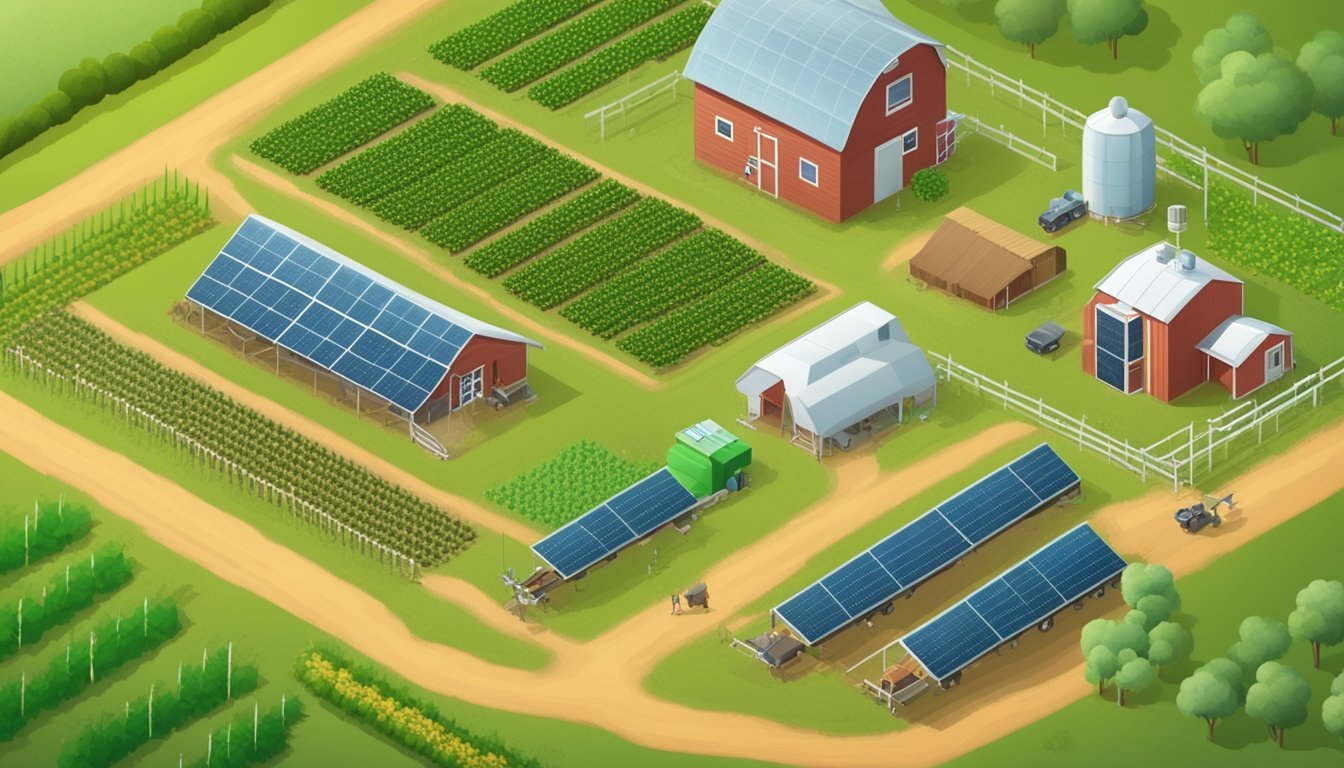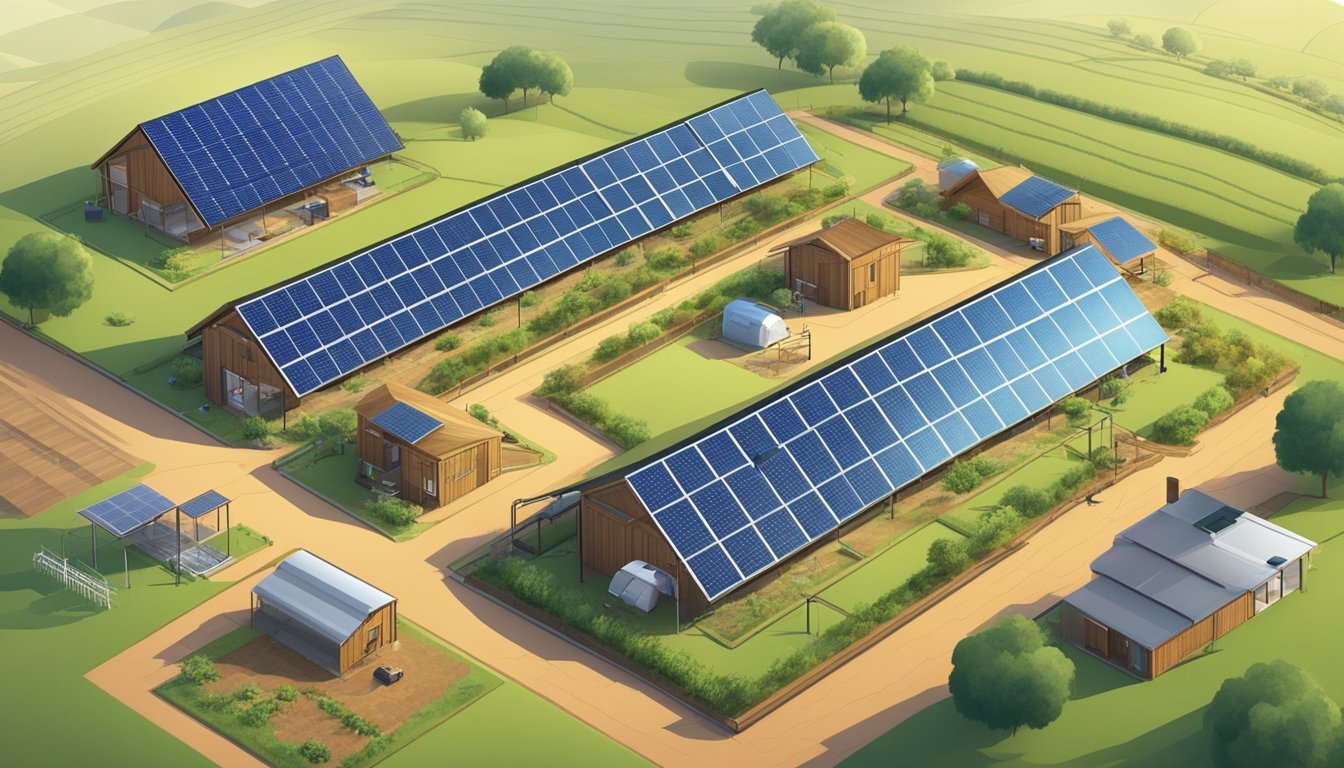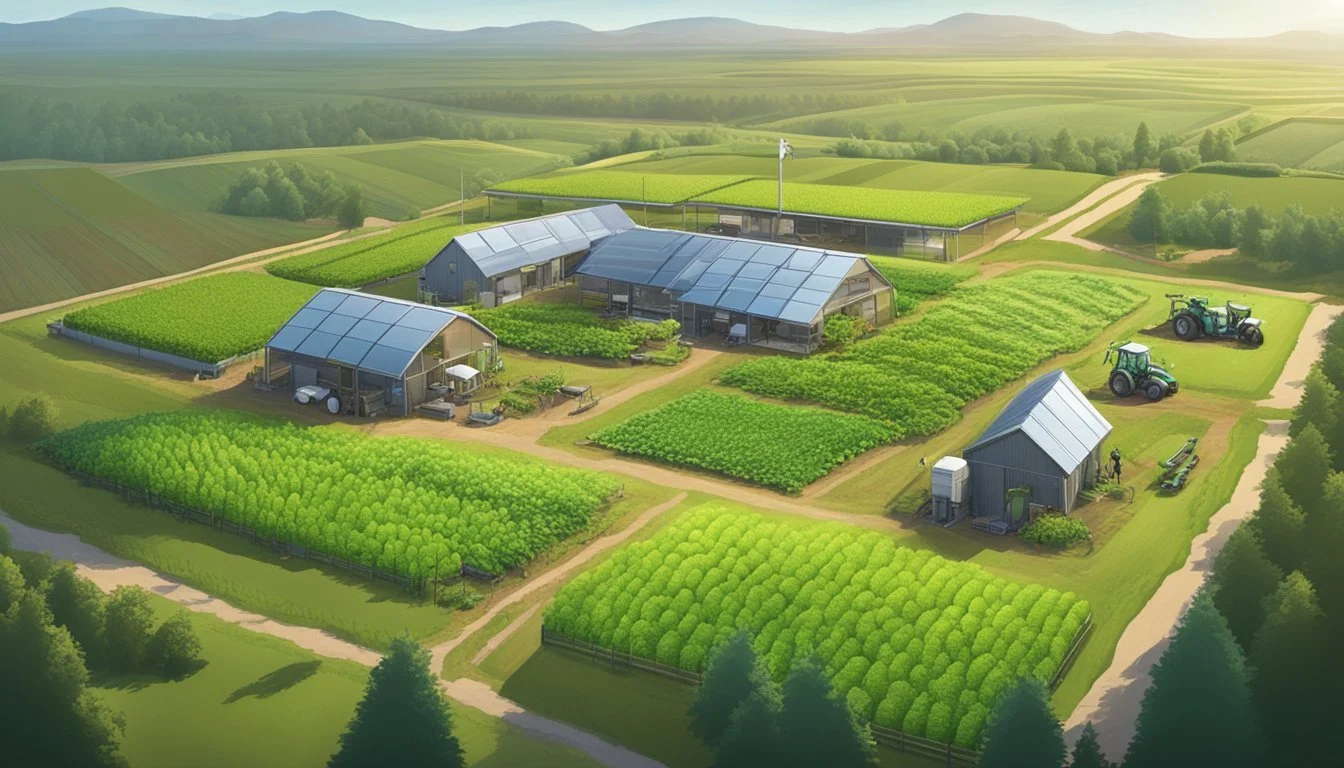Integrating Technology
Smart Farming for Homesteaders - Enhancing Agricultural Efficiency
Integrating technology in agriculture has reshaped the farming landscape, giving rise to the concept of smart farming—an innovative approach that enhances production by leveraging advanced technologies. Smart farming taps into the Internet of Things (IoT), artificial intelligence (AI), and big data to monitor crop fields, automate irrigation systems, and efficiently manage resources. For homesteaders, the incorporation of such technologies into their daily tasks represents a significant shift from traditional methods, cultivating a synergy between time-honored agricultural practices and cutting-edge innovations that bolster both productivity and sustainability.
Homesteading, often associated with self-sufficiency and a back-to-the-land philosophy, now sees a harmonious blend with smart solutions. Today's homesteaders are equipped with tools like digital smart levels and soil sensors to ease their workload and improve the precision of their efforts. This fusion of traditional knowledge and contemporary technology not only optimizes their operations but also aligns with sustainable practices, reducing waste, conserving water, and minimizing environmental impact.
As the agriculture industry evolves, so does the role of technology in empowering small-scale farmers. While industrial agriculture benefits from ag-tech on a large scale, smart farming scales down to suit the nuanced needs of homesteaders. It promises increased yields, enhanced quality, and the ability to thrive in a changing climate, ensuring that homesteaders can maintain their independence while embracing the future of farming.
Understanding Smart Farming
Smart farming represents a significant leap in optimizing agricultural practices through advanced technological means. This approach leverages cutting-edge innovations to enhance efficiency, productivity, and sustainability.
Revolution of Agriculture Through Technology
The agricultural sector has witnessed a transformative change with the advent of technology. Precision agriculture, a key aspect of this revolution, employs analytics and data to inform decision-making, enabling farmers to maximize yields while preserving resources. The interplay of sensors, connectivity, and networks has created a new environment where traditional farming methods are now augmented by intelligent insights.
Overview of Smart Farming Technologies
At the crux of smart farming technologies are systems and devices that gather and analyze vast quantities of data. This includes sensors for soil moisture and nutrients, IoT (Internet of Things) devices for tracking crop health, and automation in irrigation and fertilizing processes. The resultant data flows through a connected network, facilitating real-time management and analytics that guide farming operations.
Sensors: Detect environmental conditions
IoT devices: Provide real-time monitoring and control
Automation: Ensures consistency and efficiency in tasks
Benefits of Integrating AI and IoT in Farming
AI (Artificial Intelligence) and IoT integration stands at the forefront of advancing smart farming practices. The application of AI enhances analytical capabilities, enabling predictive analytics for crop management and pest control. IoT contributes to seamless connectivity among devices, leading to improved efficiency and informed decision-making. These integrations collectively foster an environment of sophisticated precision agriculture, where every action is data-driven and strategically planned.
AI: Powers predictive analytics
IoT: Connects devices for unified management
Practical Applications of Smart Farming
Smart farming leverages advanced technologies to optimize the efficiency of agriculture, integrating real-time data and analysis to enhance all aspects of farm management.
Soil Management and Crop Health Monitoring
Using soil sensors, farmers are able to collect detailed information on soil moisture and fertility. This data informs precise irrigation and fertilization strategies, ensuring crop health is maintained at an optimum level. Tools like spectral analysis can detect plant diseases early, facilitating timely intervention to protect yield quality.
Livestock Tracking and Health Assessment
Animal husbandry practices are revolutionized through the use of wearable technology for livestock. These devices offer real-time tracking of animal location and well-being, providing insights into behavioral patterns that may indicate health issues. Data collection on a per-animal basis allows for more personalized care.
Climate Adaptation and Resource Management
Smart farming technology plays a critical role in adapting to climate change challenges. Automated machinery helps in efficient planting and harvesting, directly impacting sustainability. Equipment outfitted with sensors can also contribute to better resource management, reducing water, and energy waste and ensuring optimal input storage and usage.
Innovation in Homestead Farming
Recent advancements in technology offer homesteaders new opportunities to enhance agricultural efficiency and productivity. These innovations range from the Internet of Things (IoT) applications to a variety of digital tools and apps that support the transition from traditional methods to more tech-savvy approaches.
Adopting IoT for Small Scale Agriculture
The implementation of Internet of Things (IoT) technology in homesteading has led to what many refer to as smart farming. Small scale operations benefit from IoT by gaining real-time data on soil moisture levels, climate conditions, and crop health. This information can result in better decision-making and precision in tasks like watering and applying fertilizers. Tools such as single-board computers (SBCs), aided by affordable electronic components and open-source software, are becoming integral for resource-conscious homesteaders.
Digital Tools and Apps for the Modern Homesteader
An array of digital tools and apps have emerged, simplifying many facets of homesteading life. From crop rotation planners to livestock management systems, these apps provide tailored solutions that streamline the modern homesteader's workload. They function as digital assistants, enabling efficient organization, record-keeping, and even direct marketing of produce to consumers.
Transition from Traditional to Technology-Enabled Farming
While many homesteaders hold traditional farming methods dear, integrating smart technologies does not necessitate abandoning these time-honored techniques. Rather, it's about supplementing them with technological aid to foster greener, more sustainable oprations. For instance, incorporating smart sensors in gardening can improve water usage, a critical step in sustainability that seamlessly blends traditional practices with today's innovation. This kind of integration helps maintain the ethos of homesteading while propelling it into a future where technology and tradition coexist.
Infrastructure and Setup
Integrating modern technology into homesteading practices involves careful consideration of infrastructure and connectivity to ensure efficient farm management. An effective setup leverages advanced hardware and communication technology to monitor and optimize irrigation, energy use, and overall farm operations.
Establishing a Farm Network and Connectivity
The backbone of a smart farm is its network infrastructure which enables connectivity between devices and central farm management systems. Homesteaders should prioritize a robust wireless network to support various IoT devices, utilizing both local and wide-area network technologies. Using emerging technologies, one can implement open-source IoT platforms to integrate unmanned aerial vehicles and other smart farming tools for a more connected and responsive agricultural environment.
Smart Irrigation and Water Management Systems
Effective water management is critical for sustainable farming. Smart irrigation systems can be integrated to tailor water delivery to the specific needs of crops, using data-driven insights. These systems leverage sensors for real-time soil moisture monitoring to apply water more efficiently and prevent waste. Homesteaders can explore advancements in smart farming that integrate Big Data Analytics and Machine Learning for a more precise irrigation strategy, optimizing water resources and enhancing crop yields.
Energy Solutions for Smart Farms
Sustainable energy solutions, such as solar energy systems, are essential for off-grid smart farming. They provide a renewable source of power to run farm equipment and technology, reducing operational costs and environmental impact. Innovative energy harvesting technologies can support smart devices, ensuring that farms maintain efficient energy use through the integration of green IoT devices and systems. This approach not only powers smart farms but also aligns with sustainable development practices.
Data-Driven Farming and Analysis
In the domain of modern homesteading, integrating data-driven practices is key to achieving higher levels of productivity and making more informed decision-making. This involves leveraging analysis of agricultural big data through artificial intelligence (AI) and machine learning (ML) technologies.
Harnessing Data for Improved Decision-Making
Data serves as the cornerstone for enhancing agricultural decisions on a homestead. Farmers utilize soil monitoring, yield mapping, and livestock monitoring to inform their practices. Collecting this data allows for the analysis of crop performance and environmental conditions, which in turn supports strategic planning and efficient resource management.
Machine Learning and Predictive Analytics in Agriculture
The application of machine learning and predictive analytics offers a profound impact on agriculture. These technologies can, for example, forecast crop yields based on historical and current data trends. Deep learning, a subset of ML, can analyze patterns and anomalies in crop health, potentially predicting diseases before they spread widely.
Impact of Real-Time Data on Farming Efficiency
Real-time data acquisition and analysis drive substantial improvements in farming efficiency. Sensors and IoT devices provide immediate insights into various factors such as soil moisture levels, optimizing irrigation. This immediacy allows farmers to rapidly respond to changing conditions, thereby enhancing crop management and reducing waste.
Cost Management and Economic Implications
When adopting smart farming technologies, homesteaders must evaluate the economic implications and strategize cost management effectively. This encompasses understanding the balance between initial costs and potential long-term savings, identifying how precision farming can lead to cost efficiencies, and being aware of government programs that provide financial support.
Balancing Initial Investments and Long-Term Savings
Investing in smart farming technologies often involves significant upfront costs. These can range from purchasing advanced equipment to installing sophisticated data analysis tools. However, these initial expenses must be weighed against the prospects of long-term savings and enhanced productivity. Over time, investment in smart systems could lead to lower operational costs and increased yields.
Cost Savings Through Precision Farming
Smart farming enables precision agriculture, where resources like water, fertilizers, and pesticides are deployed more efficiently. For instance, drones and sensors can monitor crop health and soil conditions, allowing for precise application of inputs, reducing waste, and thus, operational costs. This targeted approach not only saves money but also supports sustainable agriculture practices.
Government Incentives and Subsidies
Many governments recognize the benefits of smart farming and offer a variety of incentives and subsidies to encourage adoption. These financial aids can help offset the initial costs of technology integration. Homesteaders should research and apply for relevant programs which could include tax breaks, grant funding, or cost-sharing opportunities to alleviate the economic burden of transitioning to smart farming technologies.
Advanced Technologies in Farming
The agricultural landscape is undergoing a significant transformation through the incorporation of advanced technologies. These innovations are tailored to enhance efficiency, precision, and sustainability in farming practices.
Drone Technology for Surveillance and Crop Assessment
Drones, or unmanned aerial vehicles (UAVs), have become indispensable in modern precision farming. They provide farmers with detailed aerial imagery that aids in effective crop surveillance and assessment. Machine learning (ML) algorithms can analyze the captured data, identifying issues such as pest infestations or nutrient deficiencies. For instance, drone technology makes it possible to monitor vast fields efficiently, allowing for timely interventions that can lead to healthier crops and increased yields.
Robotics and Autonomy in Field Operations
The integration of robotics in farming operations has revolutionized traditional practices. Autonomous machines now perform various tasks—from weeding to harvesting—with precision and consistency. This reduces the need for manual labor and minimizes human error, leading to more cost-effective and streamlined field operations. Robotics also supports the concept of autonomy in agriculture, offering solutions that can independently adapt to varying conditions without constant human guidance.
High-Tech Solutions for Seed and Fertilizer Application
Advanced technologies facilitate high-precision seed and fertilizer applications, ensuring optimal plant growth and soil health. Precise placement and dosing of seeds and fertilizers are made possible through the use of equipment embedded with advanced sensing and dispensing technologies. This not only reduces wastage of resources but also contributes to sustainable farming by minimizing the environmental impact of excess fertilizer runoff.





